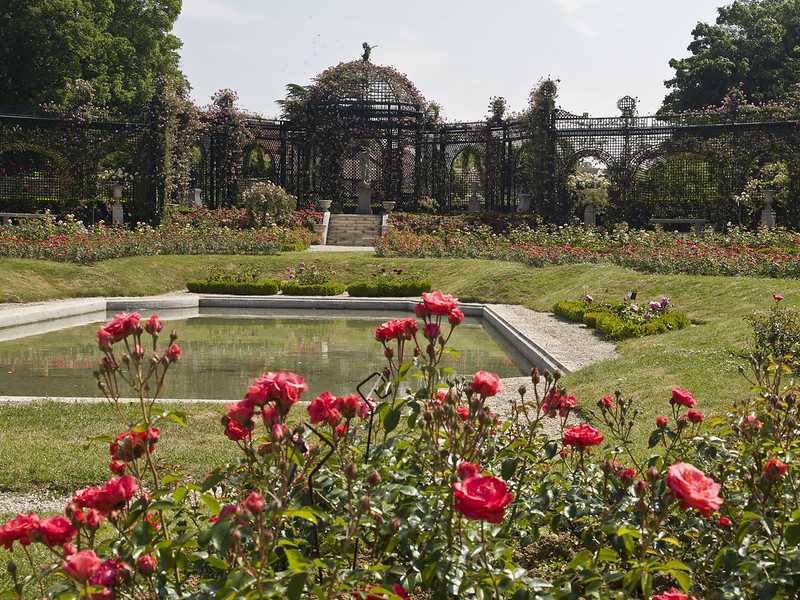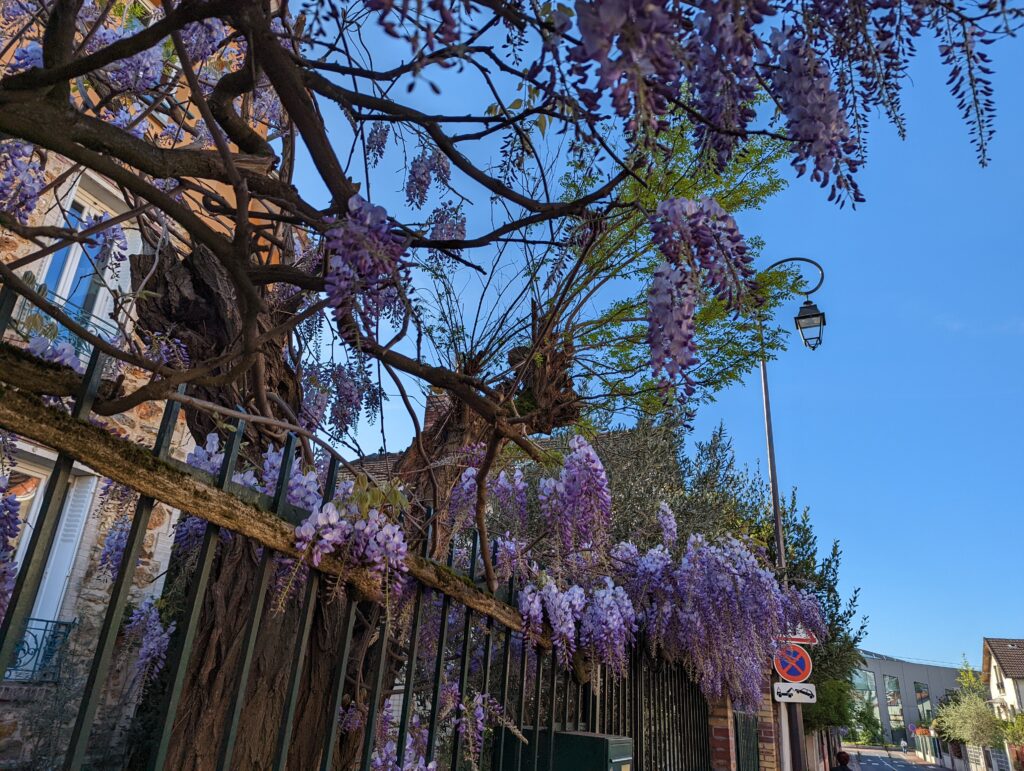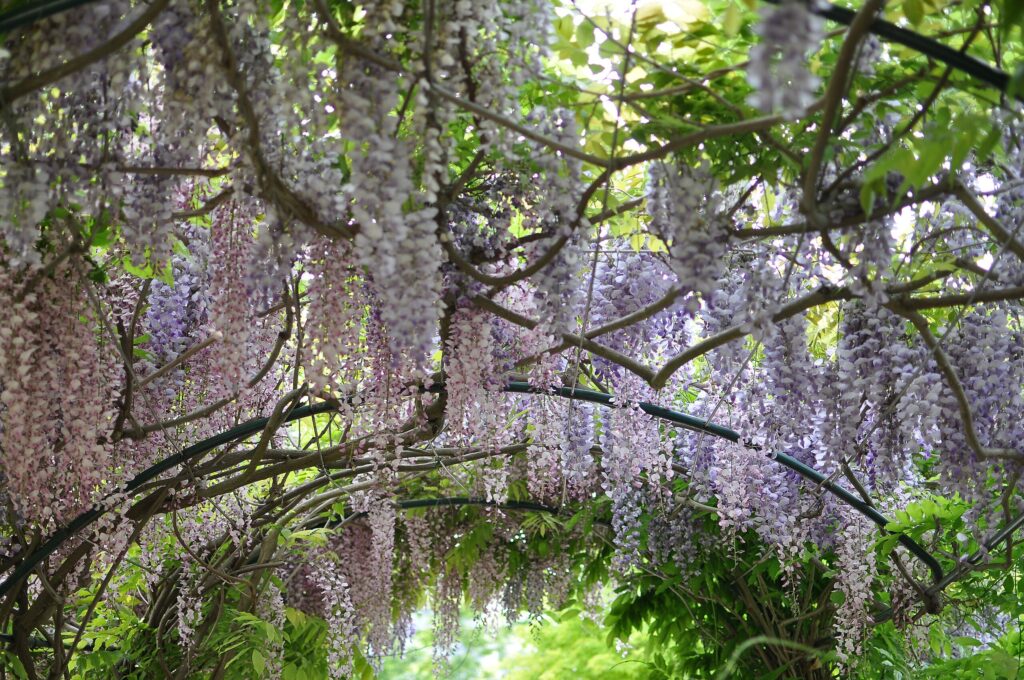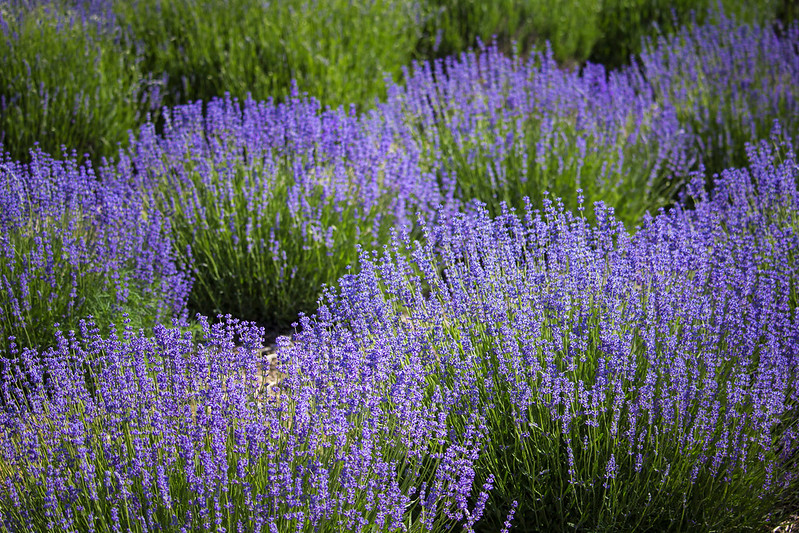Why France is a great place to enjoy scented walks? Firstly, the climate in the Parisian region is conducive to the growth of a wide variety of beautiful plants. Secondly, there is a cultural appreciation for nature and beauty in France. That leads to a widespread effort to incorporate greenery into urban environments.
France is indeed a delight for the senses, especially when it comes to aromatic plants. You can often find narrow cobblestone streets lined with charming buildings with colourful window boxes overflowing with fragrant plants like lavender, roses, and wisterias.
Additionally, many villages boast lush gardens filled with herbs like thyme, sage, and rosemary, infusing the air with their delightful scents. Let me unveil the most enchanting scented strolls just outside Paris.
Where are the best rose gardens near Paris?

“One is nearer to the heart’s desire in a garden than anywhere else on earth” said French biologist, Jean Rostand.
Rose gardens appeal to two senses: sight and smell and they are cherished for their beauty and scent. They have so many colors, ranging from classic reds and delicate pinks to striking yellows or oranges. They emit a variety of fragrances; some roses have a strong, sweet perfume, while others offer more subtle, fresh, and even spicy aromas.
The diversity in color and scent makes roses beloved in gardens and floral arrangements in France. Varieties range from climbing roses, which adorn pergolas and walls, to shrub roses that fill garden beds.
The Rose Garden of Provins (La Roserai de Provins)
11 rue des Prés, 77160 Provins
In a charming garden with winding streams, discover over 300 rose varieties arranged thematically, providing a comprehensive history of the rose across 3.5 hectares. You’ll find a variety of roses, from modern bloomers to ancient varieties like the “Rosa gallica officinalis,” symbolizing the city, introduced from the crusades in 1240.
Additionally, there’s a tea lounge and boutique offering a variety of rose-infused products such as soap, shampoo, tea, beverages, wine, honey, and more.
Provins is a remarkable medieval town 100km from Paris worth visiting. You will feel like you step back in time. I particularly love the cobbled streets everywhere and cute timbered houses.
Roseraie du Val-de-Marne
Rue Albert Watel, 94240 L’Haÿ-les-Roses
It’s a very delightful and bucolic garden with thirteen distinct collections boasting nearly 3,000 rose varieties. June offers optimal viewing of the blooms and savouring fragrant old roses such as Gallic, botanical, and Eastern varieties, now rare in commerce. Wander along the wall to discover unique collections like tea roses and rugged rose bushes.
Don’t miss the annual Rendez-vous aux jardins event in June, offering a unique perspective of the Rose Garden and a feast for all senses. The work of the gardeners is truly remarkable.
Parc de bagatelle – La Roseraie
42 Route de Sèvres à Neuilly, Paris 16th arrondissement
This beautiful and romantic rose garden is not suitable for quick activities such as running or cycling, but rather for contemplation. All your senses will be awakened during this walk.
You will be charmed by the gentle murmur of the water which accompanies your steps in the landscaped part of the park. rose garden with more than 1,200 varieties of roses.
It is one of the largest and oldest rose gardens in France garden with more than 1,200 varieties of roses. It is one of the largest and oldest rose gardens in France.
Château de Malmaison
12 Av. du Château de la Malmaison, 92500 Rueil-Malmaison
The castle is renowned for its historic rose garden, which features a diverse collection of roses. Napoleon Bonaparte’s wife, Empress Joséphine, cultivated this garden with great passion, collecting roses from around the world. Her penchant for acquisition led to the introduction of 250 new rose varieties to France.
Today, the Château de Malmaison is celebrated for preserving and showcasing Joséphine’s legacy through its stunning rose collection, which includes many rare and antique varieties.
Wisteria season in France

The blooming season is relatively short-lived, typically spanning from April to mid-May in France. Admiring the blooming wisteria provides a compelling reason to visit France in spring.
Wisteria is uniquely striking in appearance. The cascading clusters of flowers create a captivating visual spectacle. Its fragrance is equally distinctive, exuding a sweet, intoxicating scent that is both enchanting and unforgettable.
It possesses a unique and identifiable fragrance characterized by its sweet and floral notes. This aroma reaches its peak intensity during full bloom and becomes particularly prominent on days with warm, sunny weather.
Wisteria holds symbolic significance in various cultures around the world. In Japanese and Chinese culture, wisteria symbolizes beauty, grace, and longevity. During the Victorian era in England, wisteria symbolized romantic love and devotion.
In Japanese Buddhism it’s known as “Bodaiju” and symbolizes enlightenment, akin to the sacred tree “bodaiju.” Additionally, in other countries, it is linked with the terms “Blue Rain” and “Glicinia.”
The best places to see wisteria near Paris

What I truly enjoy when passing through the Parisian suburbs is discovering the beauty of plants lining the streets, adorning private gardens, or embellishing the quaint city centers. In the Parisian suburbs, numerous streets are adorned with flourishing wisteria vines.
Parc des Impressionistes, nestled in Rueil-Malmaison, is a splendid flower-filled park. Visitors are captivated by the lush wisteria blooms, creating a serene and visually stunning atmosphere. The fragrance of wisteria fills the air, enhancing the park’s tranquil charm. Art lovers appreciate the setting’s homage to the Impressionist painters who once inspired this landscape.
In Chevreuse, wisterias are plentiful, with some reaching impressive heights. Take a look at the magnificent wisterias along rue Pierre Chesneau, perfect for capturing stunning photographs. The air is filled with the sweet scent of wisteria, enhancing the wonderfully calm ambiance. The enchanting wisteria tunnels invite leisurely strolls, perfect for quiet contemplation or romantic walks.
The village of Médan with cute little streets such as Rue Pasteur. Rue Pasteur in Médan is famous for being the location of the house of the celebrated French novelist Émile Zola. Medan also boasts a stunning castle, one side of which is adorned with cascading wisterias.
Vaux-le-Vicomte Gardens is famous for their exquisite French formal design. These gardens are renowned for their geometric patterns, immaculate lawns, stunning water features, and meticulously trimmed hedges, setting the standard for classical French garden design. They served as a significant influence on the creation of the gardens at the Palace of Versailles.
Lavender is a staple in French gardens, not only in Provence region.

Finding extensive lavender fields near Paris, like those iconic to Provence, is challenging because the climate and soil conditions. However, several smaller gardens and parks near Paris cultivate lavender to some extent.
Here’s a list of places where you might find lavender planted, giving you a taste of the experience without having to travel far:
Parc de Sceaux, Orangery (L’Orangerie)
92330 Sceaux
The small formal garden hidden between the hedges in front of the imposing orangery of Parc de Sceaux (Hauts-de-Seine) surprises the walker who approaches it and discovers its brightly colored flowerbeds. The wide bands of forget-me-nots, pansies, and tulips with fleur-de-lis contrast with the fluorescent green of the borders and boxwood balls.
A few lengthy and expansive stretches of blooming lavender can be found in front of the Orangery spreading a beautiful scent from mid-June to early July.
Parc Floral de Paris
Rte de la Pyramide, 75012 Paris
Once past the entrance to the park, you reach the Jardin des Senteurs in a few steps, along the tree-lined paths. At the beginning of June, it is nice to stroll here between the climbing rose bushes on the vaulted arches.
In the aisles, lined up earthen pots offer an impressive collection of pelargoniums with scents of mint, lemon, spices. Next door, medicinal plants are displayed on small lawns such as lavender , mint and rosemary. This secret place is not known to tourists. It offers enormous space including ponds and sculptures well integrated into the regional flora.
The gardeners of the Paris floral park offer tours of the garden’s botanical collections. every Saturday, Sunday and public holiday in May. Tour departures at 3 p.m. and 4:30 p.m. The appointment for the departure of the visits is fixed at the castle entrance to the floral park, near the botanical garden greenhouse.
Saint-Germain En Laie
6-8 Rte Centrale des Noyers, 78100 Saint-Germain-en-Laye
On 29 June the Lavender Festival (la Fête de la Lavande) will, as each year, attract considerable number of visitors, who come to take part in its flagship activities such as lavender picking and other activities. The Lavender Festival takes place at SIAAP Seine Aval in Saint Germain En Laie. There will be small trains to shuttle between the Lavender Field and the Jardin de Paris.
Nature Walks – A treat for all your senses
Being attentive to the sights, sounds, scents, and flavors of the present moment is often referred to as mindfulness. Sensory walking, centered on this practice, lies at the core of broader physical and mental health benefits, including stress reduction, anxiety alleviation, and a renewed connection with nature and landscapes.
- Pause and either stand or sit quietly for a moment. Focus on a distant sound or object, then gradually bring it into your awareness.
- Take a moment to concentrate deeply on one thing, then articulate its appearance, texture, or sound to others.
- Commence your stroll gently to calm your mind; stay mindful of the present moment and attuned to your body.
- Experiment with breathing techniques such as deep, slow inhalation while observing your surroundings’ scents, or engaging in breath-holding followed by a slow exhale.
